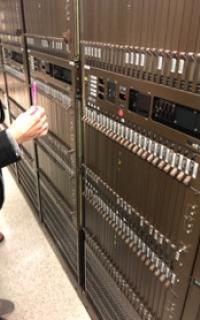 Course Description:
Course Description:
The Nortel DMS-100 is still one of the most common switches installed in the world today, and remains so due to its high reliability and low-latency for voice circuits.
This extensive Virtual Live Instructor-led DMS-100 course provides the skills required to perform maintenance and a high-degree of troubleshooting, and will walk the student through a practical understanding of the Genband (Nortel) DMS-100 switching system. It discusses the general system architecture used by all Digital Multiplex System switches, with functional block diagrams of the switch and its main modules, including the SNXAC front-end, the Network (JNET ENET), MS, CCS, IOD, and the various PM and LCM types for Line and Trunk peripherals, plus RCU, RLCM, OPM, and GR-303-compliant remotes. MAP and RTIF terminal use are explained, plus remote access through serial TTY and telnet. MAP alarm fault interpretation are demonstrated, using data from the MAP and from logs, showing the student how to locate suspect cards within the system. The Helmsman documentation viewer and Nortel Technical Publications (NTPs) are covered in detail, with an emphasis on documents used for maintenance and troubleshooting procedures.
Previous troubles are reviewed and used as exercises, including LNS line and TRKS trunk maintenance, but also parts of the SuperNodeXA-Core front-end (SN) including the Computing Module (CM), Network (NET), Message Switch (MS), and CCS (SS7) modules. Peripheral Modules (PM), and modules of particular interest to the students are emphasized. Different equipment types are compared where necessary (network CPU). IOD maintenance is also discussed, including procedures to back-up the Program and Data stores, and a discussion of how hard disks, tape, and billing devices are connected to the system. Special topics like the Star Hub, Remote Concentrating Cluster (RCC), Subscriber Module Access (SMA2), Emergency Stand Alone (ESA), Remote Measurement Module (RMM), etc. can also be discussed per the needs of the class.
Our non-intrusive exercises equip the student to conduct day-to-day maintenance activities and show how to perform troubleshooting procedures, including aspects of cabling and the backplane, which helps prepare them for higher-tier support interaction. The course is flexible, allowing the most important content for a particular group of students to be emphasized.
Students Will Learn:
Course Length:
5 Days

